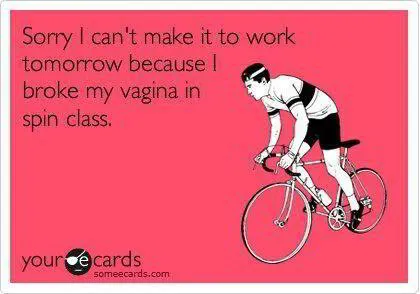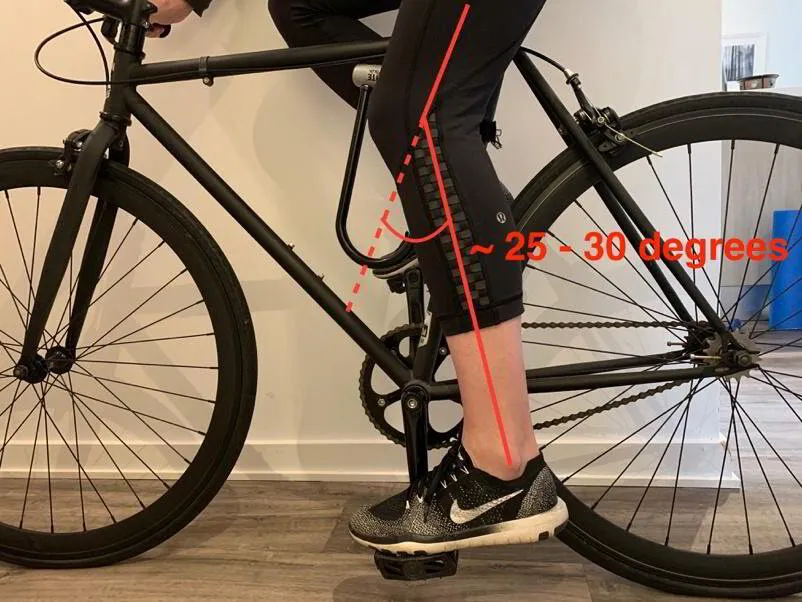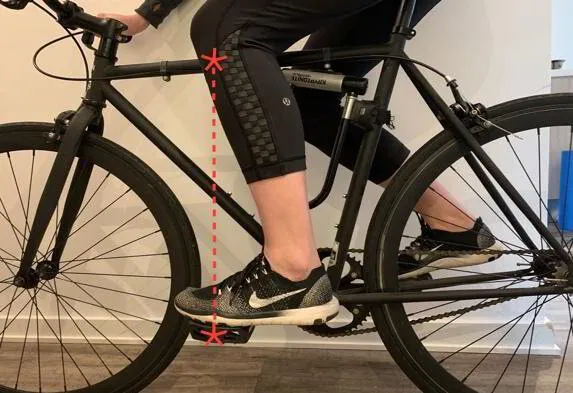Whether you are an avid spinner or a weekend cyclist, setting up your bike so that it is specific to your measurements is critical for optimizing your ride and preventing repetitive strain injuries. In this blog post, I am aiming to touch on some of the key elements to keep in mind when getting ready for your first ride this spring.
A picture containing bicycle Description automatically generated
Seat height is a commonly debated topic and there is a disconnect that is seen between researchers and bike fitting specialists (Murray & Herbert-Loisier, 2019). However, if you are just hopping on a spin bike every Saturday or dusting the cobwebs off an old bike that has been sitting in the garage, the easiest estimate is done by standing next to the bike and lining the top of the seat to your hip bone (iliac crest).
As per Bini, Hume and Croft (2011), you should have a slight bend in the knee (~ 25-30 degrees) when your foot is at the bottom of the pedal stroke (as shown below) in order to decrease the likelihood of knee injury and optimize performance by decreasing oxygen demands. Make sure to take note on your phone of the seat height or record the number if you are on a spin bike.
There are a few ways to determine if your seat height is not working for you.
Pain should be your first indicator that something needs modifying before you push up that next hill. Typically, people will report pain in the kneecap if the saddle is too low and there is excessive bending and compression through the kneecap. They may also complain of pain behind the knee if the saddle is too high from over-extending the knee.
Another indication that things need tweaking is whether you are rocking side to side in the saddle as you are too high in your seat and reaching with each pedal stroke. If you continue to experience pain even after modifications or you are clipping in, I would recommend you book an appointment with a bike fitting specialist for a more customized approach.
Setting your handlebar height is critical to minimize shoulder, neck, wrist and back strain during your ride. Depending on what type of biking you are looking to do, this will vary accordingly.
For a road bike, you want to aim for about ± 2.5cm from the top of your bike saddle. For a sport bike, you are looking at 5-10cm below the top of your saddle. It is important to play around with this range, as it will greatly affect your posture. You want to make sure that when you are settled in your seat your back is flat, you have a soft bend in the elbows and your wrists are in neutral. Furthermore, a lower position in the handlebar relative to the saddle is associated with increased saddle pressure in the groin and decreased sensation in critical pelvic floor structures (Mikhail et al.)
Another element of your bike fitting that can prevent repetitive strain is your saddle setback. This is the distance from the center of your bottom bracket and the front tip of the saddle (as shown here). For this we are aiming to balance the load that is going through the back of your thighs (glutes & hamstrings) versus the front of your thighs (quadriceps).
Modifying this setting by moving forward or back can be another way to help manage persistent knee discomfort. One of the common guiding principles is to keep the tibial tuberosity over the pedal spindle. Now you may be thinking the what over the what. I have attached a photo below to help clarify this point.
Picking a Saddle Shape can seem a little overwhelming especially when you are on the fence about telling the 18-year-old bike fitting technician about your discomfort down there. Don’t worry ladies and gents, you are not alone. Leading up to the 2012 Olympics, 100% of the female team complained of some genital discomfort and only 50% used the medical expert hired to address these complaints. In spite of the awkwardness of this conversation, I would highly encourage you to have it, as the consequences can be uncomfortable at best.
Depending on what type of cyclist you are, the area of contact in your perineum will change. If you are more of a leisure cyclist (upright posture), you will be loading in the back of your bum, whereas if you are more of an aggressive cyclist (leaning forward), the tendency is to load your genitals. If you experience chaffing, persistent numbness in the groin, sharp pain with urination, pain with sex or sexual dysfunction, I would highly recommend a follow-up with your GP and pelvic physiotherapist to get a detailed assessment.
In a study conducted by Ryu et al (2002), they showed that a narrow saddle is more associated with reductions in penile blood flow, potentially leading to erectile dysfunction. In competitive female cyclists, an association has been established between cycling and decreased genital sensation (Mikhail, M. et al, 2006).
Some considerations for bike saddle fitting are:
- Width: Measure the distance between your sitz bones to ensure that the saddle matches your anatomy. Chaffing of your inner thighs or bum may indicate that the saddle is too wide. Whereas, pain in your sitz bones that is not relieved with rest may indicate the saddle is too narrow. Although women’s sitz bones tend to be wider, this is not always the case and it is best to try the saddle out.
- Firmness: More padding is not always better! As you ride, you will sink into the cushion, creating more pressure through the sitz bones. Choose a firmer saddle for longer rides that is made of leather so that it adapts to your body.
- Length: If you are an aggressive rider, the nose should be narrower to prevent your thighs from chaffing. Trying a shorter, no-nose saddle may be another way to help reduce incidence of persistent genital numbness (Lowe et al, 2008).
- Cut-outs: If you are a more aggressive female cyclist, it is definitely worth trying a cut-out or relief channel, as these may help relieve pressure in the perineum. However, this is really dependent on your anatomy down under and there have been some reports of increased pressure.
When it comes to saddle fitting, the take home is to find a bike shop that has a liberal return policy or will allow you to sit on the saddle in the shop.
Saddle tilt is the angle of the seat as it relates to the floor. When you are just starting out, I would recommend that the saddle be parallel to the floor. Tilt can greatly affect the amount of pressure in the perineum. If you are post-partum or complaining of numbness in the saddle area after a long bike ride, you may consider tilting the saddle slightly forward to offload that area and decompress the pudendal nerve (the one that controls all sexual functioning).
According to Graham et al (2017), a downward tilt (5%) in the saddle may be beneficial during an upper hill climb. However, to keep things simple, I would recommend standing up while tackling those hills and every 10-15 minutes during your ride to prevent any unnecessary compression in your nether regions.
My last recommendation is to invest in a basket, panier or bag rack, as this can help alleviate tension headaches on those longer rides! Whether you are biking for your commute or just going for a trip to the park, carrying a purse, backpack or groceries for a prolonged period of time can be the perfect storm, creating tenderness in your traps, at the base of your skull and between the shoulder blades.
So now if you have made it this far, we have gone through the basics of bike fitting. If after your self-modifications, you are still experiencing pain in your joints, persistent numbness or swelling in the groin, it is safe to say something is not working. I would recommend you take a break to allow things to settle down and book an appointment with your physiotherapist and a bike fitting specialist at your local shop!
Liseanne Nelson, Physiotherapist
Liseanne graduated from McGill University in 2014 with a Bachelor of Science in Kinesiology and then returned home to complete her Masters in Physical Therapy at the University of Toronto in 2016. She then practiced in Canada for two years, gaining a wide variety of experience in both the hospital and private practice setting. Her experience includes outpatient amputee rehabilitation, pulmonary rehabilitation, complex continuing care, and outpatient orthopedics. Looking to challenge herself further, Liseanne completed her licensing exam for the United States in 2017 where she spent a year working at a sports medicine clinic in Manhattan.
Now back in Toronto, Liseanne is thrilled to join the Body Co team! Her treatment approach consists of a combination of manual therapy, patient education, therapeutic exercise, kinesiotaping and modalities for pain management. Liseanne has additional training in Pelvic Floor Physiotherapy and is able to treat a wide variety of conditions including diastasis recti, incontinence, pelvic organ prolapse, and pelvic pain. Liseanne is constantly taking new courses to improve patient outcomes and to stay up to date with current best practices.
In her spare time, Liseanne enjoys skiing, hiking, yoga, running, and playing fetch with her dogs Morgan and Charlie!
If you have enjoyed this blog and would like to learn more about health and wellness from our team of expert practitioners, follow us on Facebook and Instagram.
References
Bini, R., Hume, P. A., & Croft, J. L. (2011). Effects of bicycle saddle height on knee injury risk and cycling performance. Sports Medicine, 41(6), 463-476.
Hynd, J., Cooley, D., & Graham, M. (2017). Saddle tilt during uphill cycling improves perceived comfort levels, with corresponding effects on saddle pressure in highly trained cyclists. Journal of Science and Cycling, 6(3).
Jeong, S. J., Park, K., Moon, J. D., & Ryu, S. B. (2002). Bicycle saddle shape affects penile blood flow. International journal of impotence research, 14(6), 513-517.
Murray, J., & Hébert-Losier, K. (2019). Bike fit practices do not match scientific evidence. In Summer Research Scholarship Programme 2018/2019 (pp. 29-29).
Partin, S. N., Connell, K. A., Schrader, S., LaCombe, J., Lowe, B., Sweeney, A., … & Mikhail, M. (2012). The bar sinister: Does handlebar level damage the pelvic floor in female cyclists?. The journal of sexual medicine, 9(5), 1367-1373.
Guess, M. K., Connell, K., Schrader, S., Reutman, S., Wang, A., LaCombe, J., … & Mikhail, M. (2006). WOMEN’S SEXUAL HEALTH: Genital Sensation and Sexual Function in Women Bicyclists and Runners: Are Your Feet Safer than Your Seat?. The journal of sexual medicine, 3(6), 1018-1027.
Schrader, S. M., Breitenstein, M. J., & Lowe, B. D. (2008). ERECTILE DYSFUNCTION: Cutting Off the Nose to Save the Penis. The journal of sexual medicine, 5(8), 1932-1940.







